Discover 35 hidden attractions, cool sights, and unusual things to do in Leicester (United Kingdom). Don't miss out on these must-see attractions: Leicester Abbey, Abbey Park, and Leicester Market. Also, be sure to include Abbey Pumping Station in your itinerary.
Below, you can find the list of the most amazing places you should visit in Leicester (England).
Table of Contents
Leicester Abbey
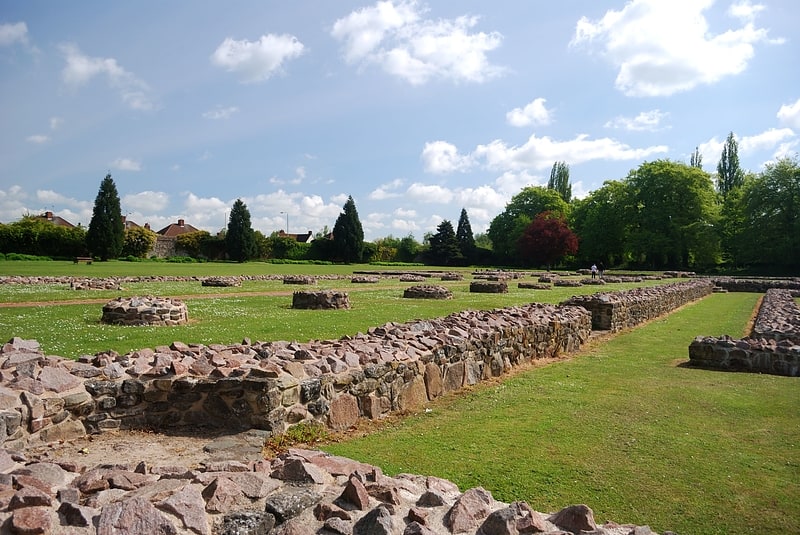
Abbey. The Abbey of Saint Mary de Pratis, more commonly known as Leicester Abbey, was an Augustinian religious house in the city of Leicester, in the East Midlands of England. The abbey was founded in the 12th century by the Robert de Beaumont, 2nd Earl of Leicester, and grew to become the wealthiest religious establishment within Leicestershire. Through patronage and donations the abbey gained the advowsons of countless churches throughout England, and acquired a considerable amount of land, and several manorial lordships. Leicester Abbey also maintained a cell at Cockerham Priory, in Lancashire. The Abbey's prosperity was boosted through the passage of special privileges by both the English Kings and the Pope. These included an exemption from sending representatives to parliament and from paying tithe on certain land and livestock. Despite its privileges and sizeable landed estates, from the late 14th century the abbey began to suffer financially and was forced to lease out its estates. The worsening financial situation was exacerbated throughout the 15th century and early 16th century by a series of incompetent, corrupt and extravagant abbots. By 1535 the abbey's considerable income was exceeded by even more considerable debts.
The abbey provided a home to an average of 30 to 40 canons, sometimes known as Black Canons, because of their dress (a white habit and black cloak). One of these canons, Henry Knighton, is notable for his Chronicle, which was written during his time at the abbey in the 14th century. In 1530 Cardinal Thomas Wolsey died at the abbey, whilst travelling south to face trial for treason. A few years later, in 1538, the abbey was dissolved, and was quickly demolished, with the building materials reused in various structures across Leicester, including a mansion which was built on the site. The house passed through several aristocratic families, and became known as Cavendish House after it was acquired by the 1st Earl of Devonshire, in 1613. The house was eventually looted and destroyed by fire in 1645, following the capture of Leicester during the English Civil War.
Part of the former abbey precinct was donated to Leicester Town Council (the predecessor of the modern City Council) by the 8th Earl of Dysart. In 1882 it was opened by The Prince of Wales and became known as Abbey Park. The remaining 32 acres (13 ha), which included the abbey's site and the ruins of Cavendish House, were donated to the council by the 9th Earl of Dysart in 1925 and, following archaeological excavations, opened to the public in the 1930s. Following its demolition, the exact location of the abbey was lost; it was only rediscovered during excavations in the 1920s/30s, when the layout was plotted using low stone walls. The abbey has been extensively excavated and was previously used for training archaeology students at the University of Leicester. Leicester Abbey is now protected as a scheduled monument and is Grade I Listed.[1]
Address: Abbey Park Road, Leicester (Leicester West)
Abbey Park
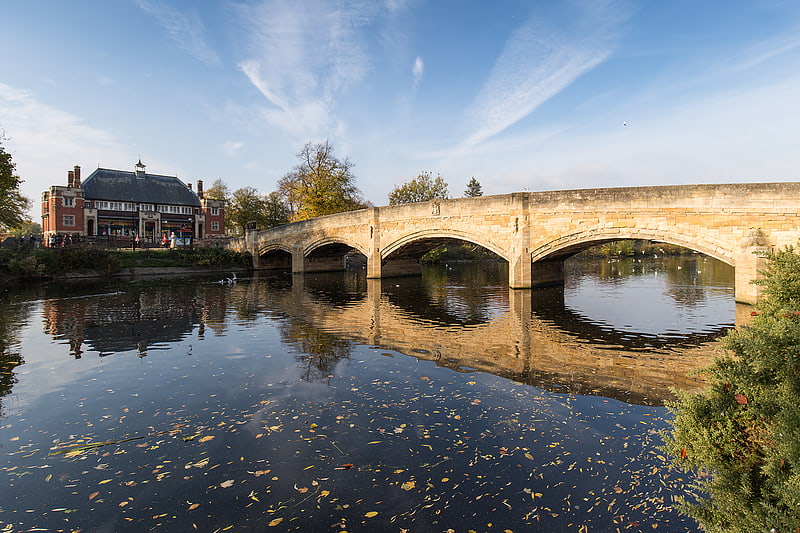
City park in Leicester, England. Abbey Park is a public park in Leicester, England, through which the River Soar flows. It is owned and managed by Leicester City Council. It opened in 1882 on the flood plain of the River Soar, and expanded in 1932 to include the area west of the river that had formerly been the medieval St Mary's Abbey, still bounded by large medieval walls. The park includes the archaeological sites of the Abbey and the ruins of Cavendish House, along with a wide range of decorative and recreational parkland features.[2]
Address: Abbey Park Road, Leicester (Leicester West)
Leicester Market
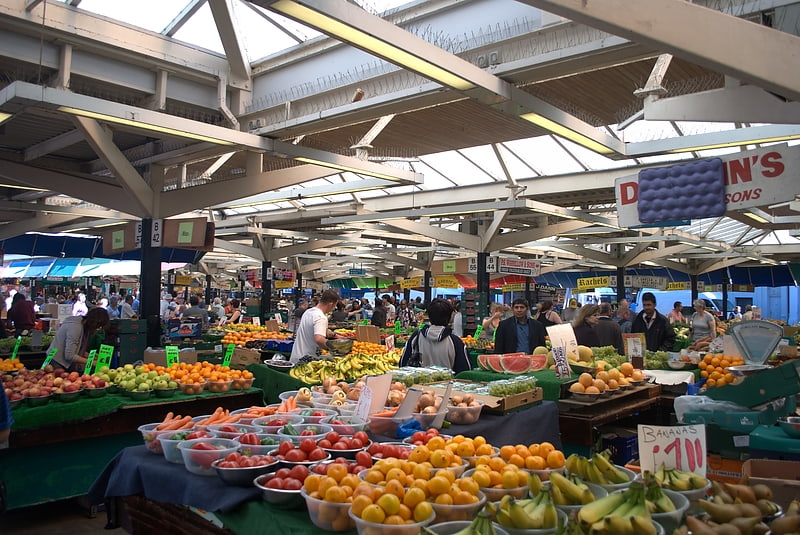
Market in Leicester, England. Leicester Market is a market in The City of Leicester, England, on Market Place just south of the clock tower. It is around 800 years old and was moved to the current site around 700 years ago. It is the largest outdoor covered market in Europe.
It is open Monday to Saturday 7am - 6pm and has over 270 stalls. The outdoor market sells a wide variety of goods, particularly fruit and vegetables, but also flowers, clothes, second-hand-books, bric-a-brac and jewellery. It also has a number of permanent units, containing clothes, cosmetics, fabrics, greetings cards, a cafe and pet products.
The former indoor market, built in 1973, was a multi-level building containing the fish market and delicatessen, as well as stalls selling clothes, haberdashery, footwear, jewellery, gemstones, and confectionery. It was demolished between December 2014 /June 2015 and the levelled site turned into New Market Square. The traders who were based there either moved to the new Food Hall - built adjacent to The Corn Exchange as a partial replacement and opened in April 2014 - or to stalls on the Outdoor Market.
In the centre of the market stands the Leicester Corn Exchange (1850), originally built as a trading centre, but now serving as a bar and restaurant. A statue of John Manners, 5th Duke of Rutland stands close to the Corn Exchange.
A monthly Farmers' Market is held nearby on Gallowtree Gate on the last Wednesday of every month, specializing in locally produced organic meat, fruit and vegetables.[3]
Address: 2 _ 4 Market Place South, LE1 5HB Leicester (Leicester South)
Abbey Pumping Station
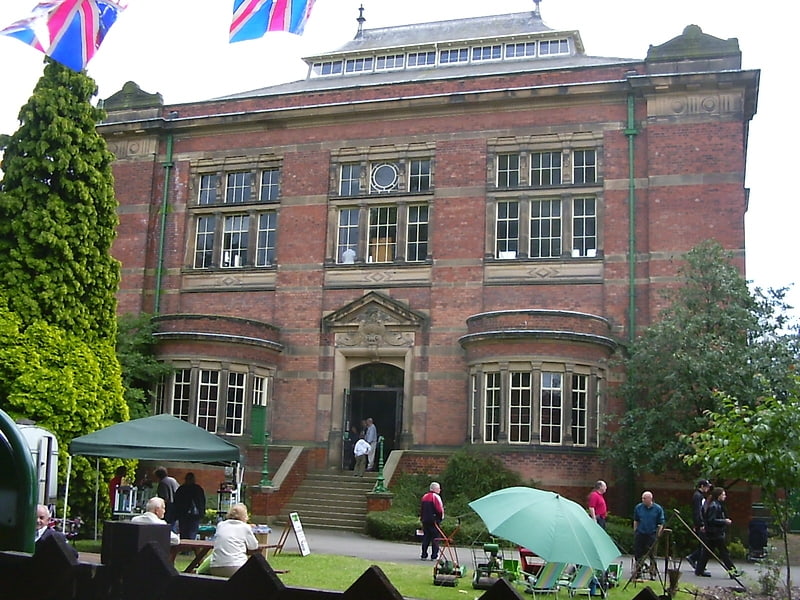
Museum in Leicester, England. The Abbey Pumping Station is a museum of science and technology in Leicester, England, on Corporation Road, next to the National Space Centre. With four working steam-powered beam engines from its time as a sewage pumping station, it also houses exhibits for transport, public health, light and optics, toys and civil engineering.[4]
Address: Corporation Rd, LE4 5PX Leicester (Leicester West)
Haymarket Memorial Clock Tower
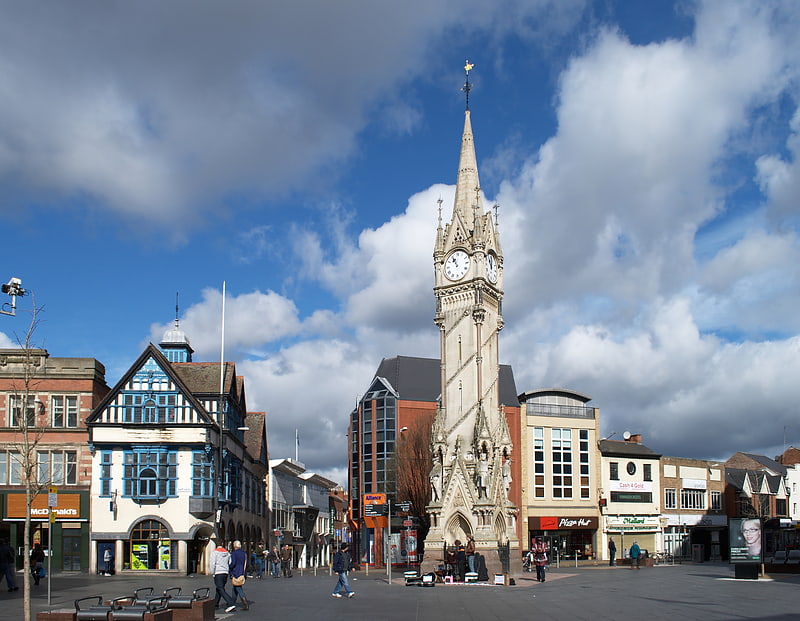
Historical landmark in Leicester, England. The Haymarket Memorial Clock Tower is a major landmark and popular meeting point in Leicester, United Kingdom. It is located roughly in the middle of the area inside the ring-road, and is at the point where five major streets meet; Gallowtree Gate, Humberstone Gate, Haymarket, Church Gate and Eastgates.[5]
Leicester Cathedral
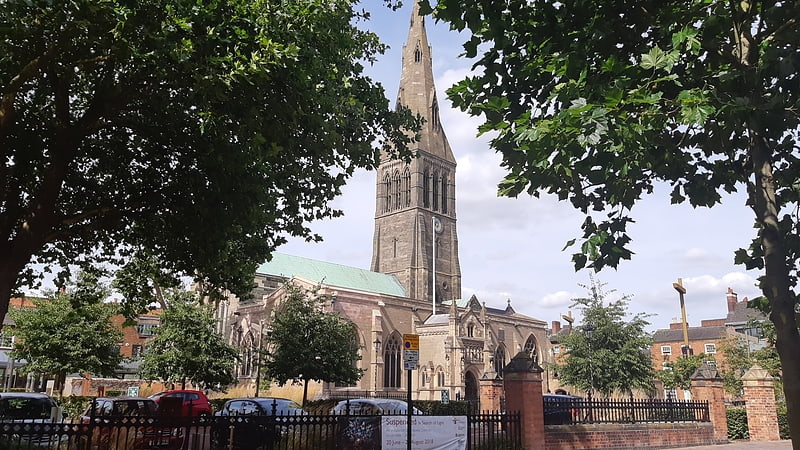
Medieval edifice and a spire built in 1757. The Cathedral Church of Saint Martin, Leicester, commonly known as Leicester Cathedral, is a Church of England cathedral in Leicester, England and the seat of the Bishop of Leicester. The church was elevated to a collegiate church in 1922 and made a cathedral in 1927 following the establishment of a new Diocese of Leicester in 1926.
The remains of King Richard III were reburied in the cathedral in 2015 after being discovered nearby in the foundations of the lost Greyfriars chapel.[6]
Address: 2 Peacock Ln, LE1 5FQ Leicester (Leicester South)
Leicester Town Hall

City or town hall in Leicester, Massachusetts. Leicester Town Hall stands in the city centre of Leicester, England, in a square which contains a fountain. The building, which contains a Bike Park, is the main office of the City of Leicester. It is a Grade II* listed building.[7]
Address: Town Hall Square, Leicester (Leicester South)
Welford Road Stadium
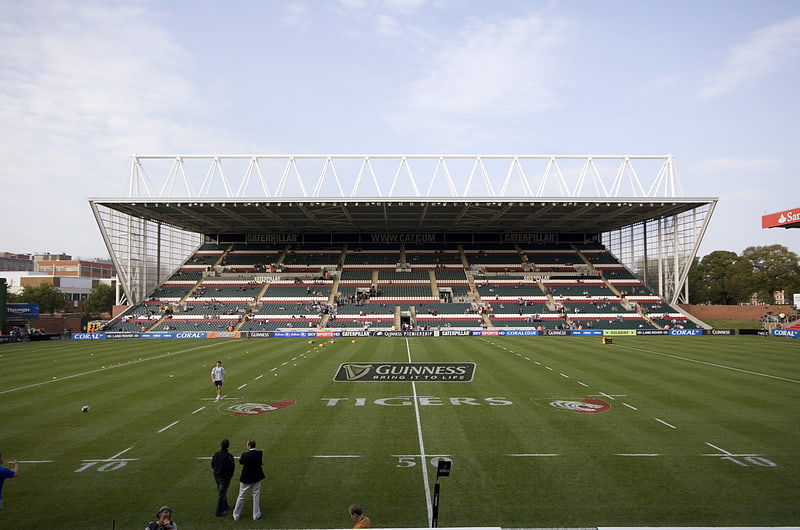
Stadium in Leicester, England. Welford Road is a rugby union stadium in Leicester, England, and is the home ground of Leicester Tigers. The ground was opened on 10 September 1892, and is located between Aylestone Road and Welford Road on the southern edge of the city centre. The ground was developed in two main periods: either side of the First World War stands were built on both sides, and then between 1995 and 2016 both ends were developed and the north side redeveloped. The stadium has a capacity of 25,849, making it the largest purpose-built club rugby union ground in England. It hosted five full England national team matches between 1902 and 1923, and staged a single match at both the 1991 and 1999 Rugby World Cups.[8]
Address: Aylestone Road, LE2 7TR Leicester (Leicester South)
Victoria Park

Park in Leicester, England. Victoria Park in Leicester, England is a public park of 69 acres. It is in the south-east, just outside the city centre, backing on to the University of Leicester and close to the Leicester railway station.[9]
Address: Victoria Park Rd, Leicester (Leicester South)
Newarke Houses Museum

Museum in Leicester, England. The Newarke Houses Museum is a public museum in Leicester, England. It incorporates the museum of the Royal Leicestershire Regiment, and has a range of exhibits illustrating post-medieval and contemporary Leicester. The museum is close to the 15th century Magazine Gateway and within the precincts of the medieval 'Newarke', the 'New Work' of Henry of Grosmont, 1st Duke of Lancaster. The museum stands in the middle of the De Montfort University campus.[10]
Address: The Newarke, LE2 7BY Leicester (Leicester South)
King Richard III Visitor Centre
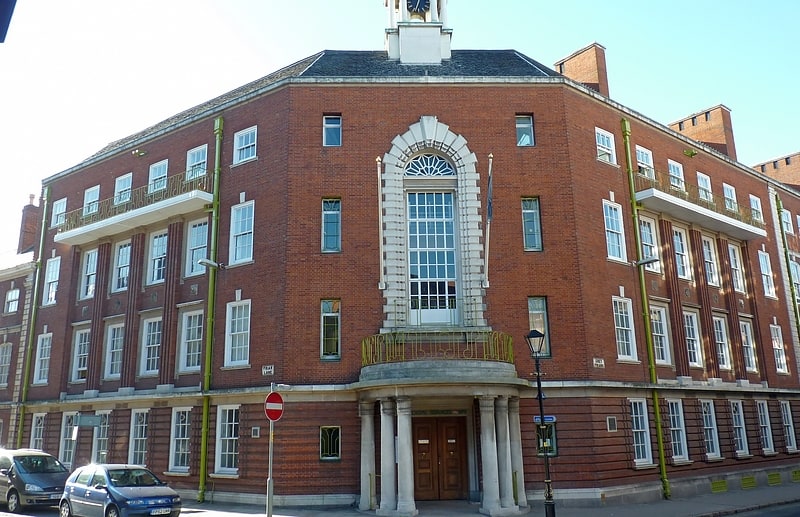
The remains of Richard III, the last English king killed in battle, were discovered within the site of the former Grey Friars Priory in Leicester, England, in September 2012. Following extensive anthropological and genetic testing, the remains were ultimately reinterred at Leicester Cathedral on 26 March 2015.
Richard III, the final ruler of the Plantagenet dynasty, was killed on 22 August 1485 in the Battle of Bosworth Field, the last significant battle of the Wars of the Roses. His body was taken to Greyfriars, Leicester, where it was buried in a crude grave in the friary church. Following the friary's dissolution in 1538 and subsequent demolition, Richard's tomb was lost. An erroneous account arose that Richard's bones had been thrown into the River Soar at the nearby Bow Bridge.
A search for Richard's body began in August 2012, initiated by the Looking for Richard project with the support of the Richard III Society. The archaeological excavation was led by the University of Leicester Archaeological Services, working in partnership with Leicester City Council. On the first day a human skeleton belonging to a man in his thirties was uncovered showing signs of severe injuries. The skeleton, which had several unusual physical features, most notably scoliosis, a severe curvature of the back, was exhumed to allow scientific analysis. Examination showed that the man had probably been killed either by a blow from a large bladed weapon, probably a halberd, which cut off the back of his skull and exposed the brain, or by a sword thrust that penetrated all the way through the brain. Other wounds on the skeleton had probably occurred after death as "humiliation injuries", inflicted as a form of posthumous revenge.
The age of the bones at death matched that of Richard when he was killed; they were dated to about the period of his death and were mostly consistent with physical descriptions of the king. Preliminary DNA analysis showed that mitochondrial DNA extracted from the bones matched that of two matrilineal descendants, one 17th-generation and the other 19th-generation, of Richard's sister Anne of York. Taking these findings into account along with other historical, scientific and archaeological evidence, the University of Leicester announced on 4 February 2013 that it had concluded beyond reasonable doubt that the skeleton was that of Richard III.
As a condition of being allowed to disinter the skeleton, the archaeologists agreed that, if Richard were found, his remains would be reburied in Leicester Cathedral. A controversy arose as to whether an alternative reburial site, York Minster or Westminster Abbey, would be more suitable. A legal challenge confirmed there were no public law grounds for the courts to be involved in that decision. Reinterment took place in Leicester on 26 March 2015, during a televised memorial service held in the presence of the Archbishop of Canterbury and senior members of other Christian denominations.[11]
Address: 4A St. Martins, LE1 5DB Leicester (Leicester South)
Gas Museum
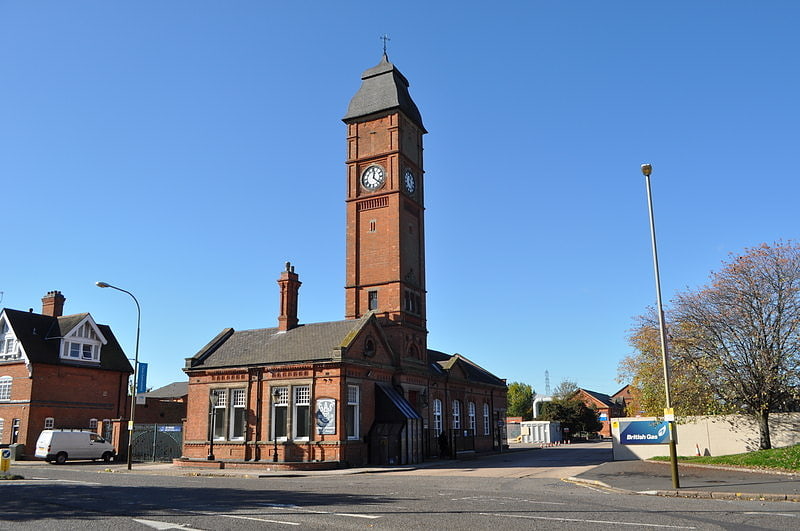
Museum in Leicester, England. The Gas Museum, also known as the National Gas Museum, is situated in the former gatehouse of a gasworks in Leicester, England, and deals with the history of domestic and industrial gas supply. It is claimed to be "the biggest collection of gas and gas related artefacts in the world".
The building is a Grade II listed building, dating from 1878, with a clock tower. The public museum is on two floors, with over 4000 items in storage. It was opened 29 April 1977, then called the John Doran Museum. It was one of 2 museums run by the British Gas Corporation until its privatization in 1987 when it was taken over by the National Gas Museum Trust, a charity set up for the purpose. The collections of the London Gas Museum and of the South West Gas Historical Society were transferred to this site in 1998.
Displays include accounts of the history of gas usage in the UK and examples of technology. There is a tableau of 1920s kitchen with gas equipment. Domestic items include washing machines, gas irons and even a gas-powered radio. Much of the collection is of items made to operate on town gas which had to be replaced when UK gas supplies were changed over to natural gas in the 1970s, and were collected by British Gas engineers.
It is run by the National Gas Museum Trust with financial support from Centrica and National Grid plc.[12]
Address: 195 Aylestone Road, LE2 7QJ Leicester (Leicester South)
Belgrave Hall

Building in Leicester, England. Belgrave Hall is a Queen Anne-style Grade II* listed building in Belgrave. It is located on the northern edge of the city of Leicester.[13]
Address: Leicester, Church Road, Belgrave
Kirby Muxloe Castle
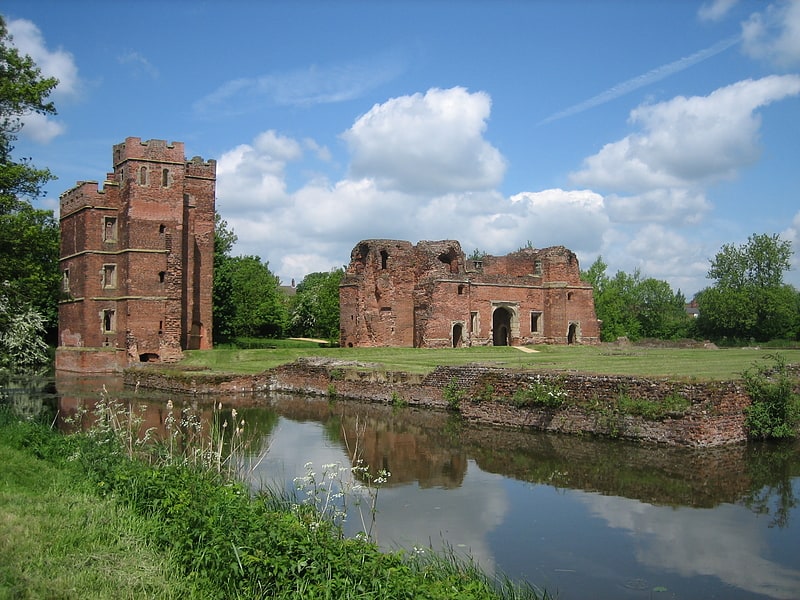
Castle in Kirby Muxloe, England. Kirby Muxloe Castle, also known historically as Kirby Castle, is a ruined, fortified manor house in Kirby Muxloe, Leicestershire, England. William, Lord Hastings, began work on the castle in 1480, founding it on the site of a pre-existing manor house. William was a favourite of King Edward IV and had prospered considerably during the Wars of the Roses. Work continued quickly until 1483, when William was executed during Richard, Duke of Gloucester's, seizure of the throne. His widow briefly continued the project after his death but efforts then ceased, with the castle remaining largely incomplete. Parts of the castle were inhabited for a period, before falling into ruin during the course of the 17th century. In 1912, the Commissioners of Work took over management of the site, repairing the brickwork and carrying out an archaeological survey. In the 21st century, the castle is controlled by English Heritage and open to visitors.
The castle was rectangular in design, 245 by 175 feet (75 by 53 m) across, and would have comprised four corner towers, three side towers and a large gatehouse, all protected by a water-filled moat; the centre of the castle would have formed a courtyard. Of these buildings, only the gatehouse and the west tower survive today, partially intact. They are constructed with decorative brickwork and stone detailing, in a fashionable late 15th-century style, and have various symbols built into their walls using darker bricks. Twelve gunports for early gunpowder artillery were built into the walls of these two buildings, although historians are uncertain whether these defences were intended to be practical or symbolic. The government body Historic England considers the castle to be a "spectacular example of a late medieval quadrangular castle of the highest status".[14]
Address: Off Oakcroft Ave, Leicester
Jewry Wall
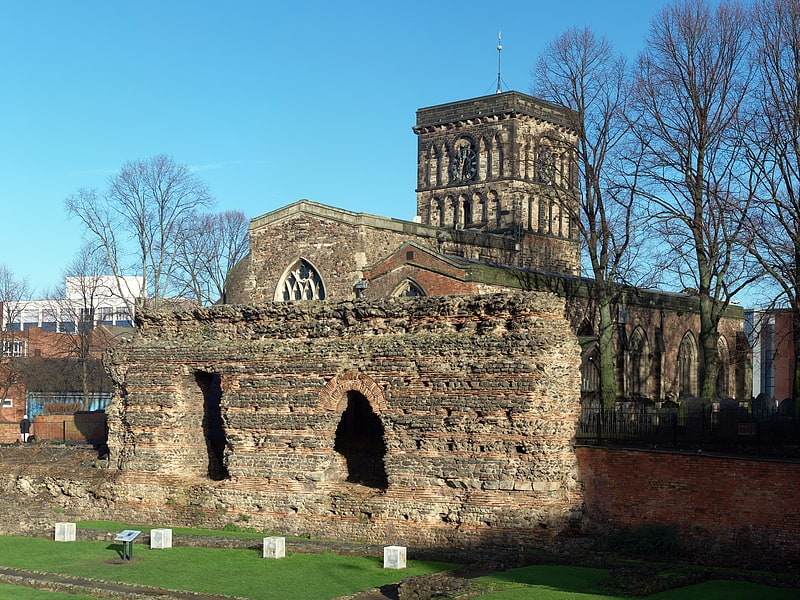
The Jewry Wall is a substantial ruined wall of 2nd-century Roman masonry, with two large archways, in Leicester, England. It stands alongside St Nicholas' Circle and St Nicholas' Church. It formed the west wall of a public building in Ratae Corieltauvorum, alongside public baths, the foundations of which were excavated in the 1930s and are also open to view. The wall gives its name to the adjacent Jewry Wall Museum.[15]
Address: Off Oakcroft Ave, LE1 4LB Leicester (Leicester West)
Phoenix Square
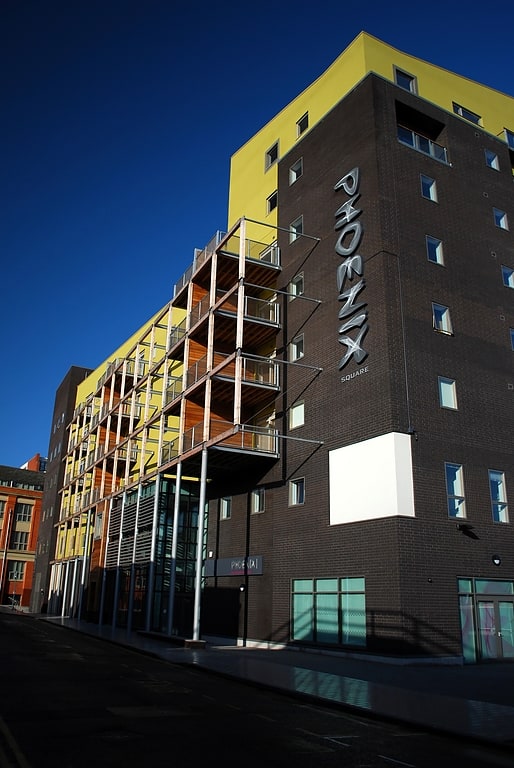
Phoenix Cinema and Arts Centre is a cinema, art gallery and café bar in the city centre of Leicester, England. The two modern cinema screens show everything from micro-budget independent films to the latest Hollywood blockbusters, and there are often festivals and events. The regularly changing art programme presents work by local and international artists, and the education programme provides courses for people of all ages to learn about, and create their own, film and art. During 2014-2015 the venue hosted over 200,000 visitors.
Phoenix is a charity with an overarching aim to 'bring inspiring film and art to all' and was established in 1989. This mission is enacted through its education programme, grants and events to develop upcoming artistic talent and efforts to widen access to cinema, especially through its travelling community cinema. Much of this work is financed through its mainstream cinema ticket sales and its cafe-bar, with sales in these areas increasing by around 10% during 2014-2015.
The venue is currently situated in the Phoenix Square building. Work began on constructing the £21.5 million scheme in November 2007 and was completed in Autumn 2009: Phoenix Square officially opened on 19 November 2009. The cinema replaces the Phoenix Arts Centre, and maintains strong links with De Montfort University. The building houses a digital exhibition space and digital production facilities, two cinema screens, a screen room and screen lounge. Space is provided for 37 new creative businesses, as well as a cafe/bar open to the public.
The venue was formerly known as Phoenix Square, and has been previously referred to as Leicester Digital Media Centre.[16]
Address: 4 Midland St, LE1 1TG Leicester (Leicester South)
Leicester Museum & Art Gallery
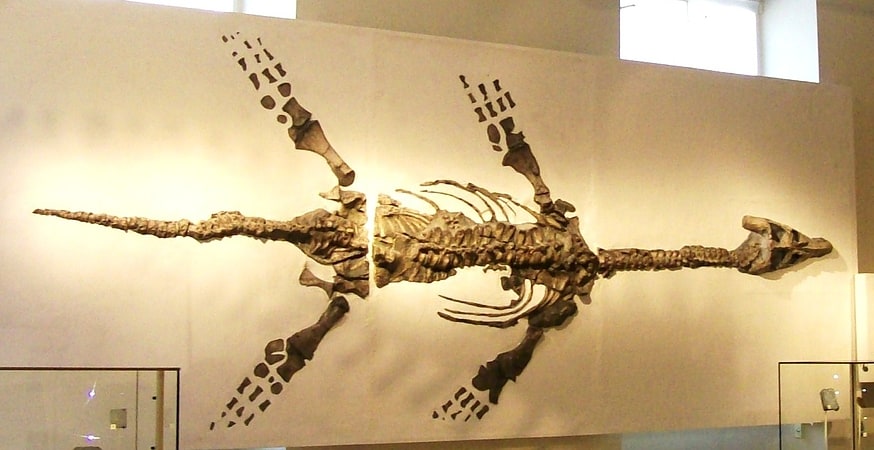
Museum in Leicester, England. The Leicester Museum & Art Gallery is a museum on New Walk in Leicester, England, not far from the city centre. It opened in 1849 as one of the first public museums in the United Kingdom. Leicester Museum & Art Gallery contains displays of science, history and art, both international and local. The original building was designed by Joseph Hansom, designer of the hansom cab. It has been expanded several times, most recently in 2011.[17]
Aylestone
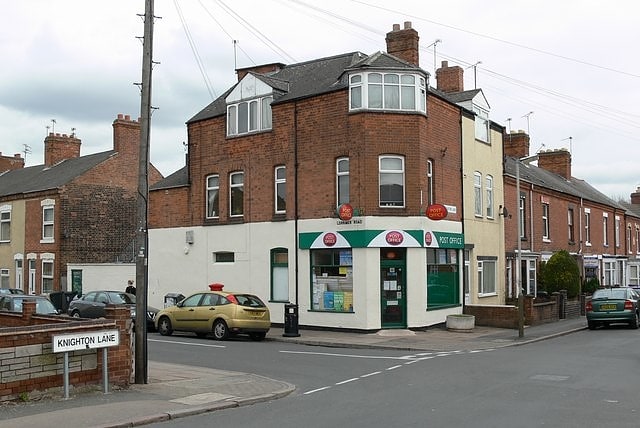
Aylestone is a suburb of Leicester, England, southwest of the city centre and to the east of the River Soar. It was formerly a separate village, but the growth of the city since the Leicester Extension Act of 1891 incorporated Aylestone into the Borough of Leicester and it is now part of the suburban area.
St Andrew's Church, Aylestone dates mostly from the 13th century. The area around the church retains much of the former village character and is referred to as 'the village' or 'old Aylestone' by local residents. The former village is largely surrounded by Victorian housing close to the city centre (known as Aylestone Park) and by 20th-century housing in other directions.
The electoral ward of Aylestone (Leicester City Council) covers 'Old Aylestone' village (including the conservation area), the Gilmorton estate, the south and west of Aylestone Park (the remainder is in Saffron ward) and the southwest side of Saffron Lane (to Grace Road). The ward borders Saffron and Eyres Monsell wards and the county parish of Glen Parva and is in the parliamentary constituency of Leicester South. The ward has two elected councillors: currently these are Councillor Adam Clarke (Labour, first elected 2011, currently deputy city mayor) and Councillor Nigel Porter (formerly Conservative, from 2011 a Liberal Democrat).[18]
De Montfort Hall
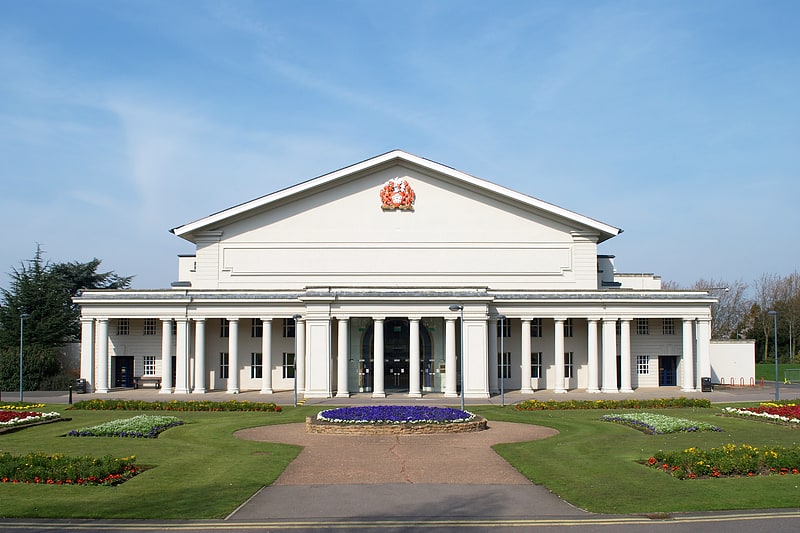
Concert hall in Leicester, England. De Montfort Hall is the largest music and performance venue in Leicester, England. It is situated adjacent to Victoria Park and is named after the Father of Parliament Simon de Montfort, Earl of Leicester.[19]
Address: Leicester, Granville Road
Clarendon Park Congregational Church
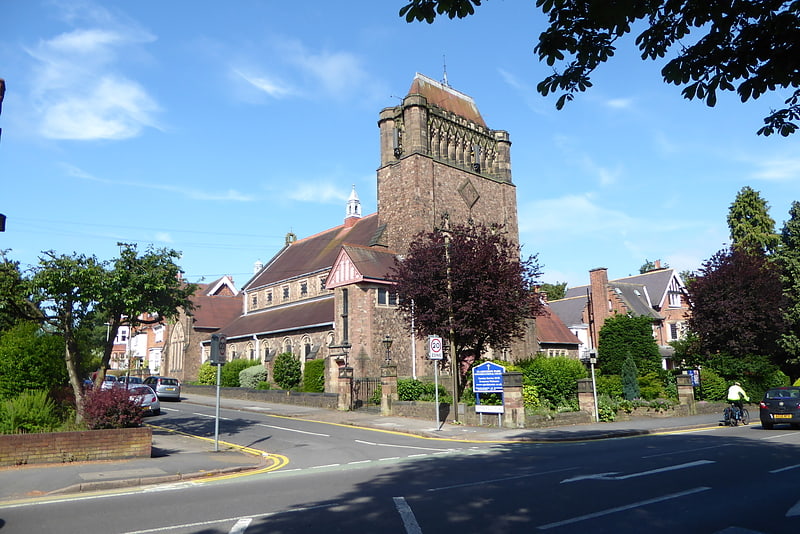
Church in Leicester, England. The Clarendon Park Congregational Church is a Congregational church in Leicester, Leicestershire, UK. It is located on London Road in the Stoneygate district near Clarendon Park.
Among the many places of worship in Leicester are Congregational churches. The first Congregational church in Leicester was founded in 1801. Numerous others were built in the 19th century. The Clarendon Park Congregational Church was designed by James Tait (1834-1915) and built in 1886. It is built of granite rubble with ashlar dressings and a roof of red tiles. It was designated a Grade II listed building (13613930) in 1975.
The church is part of the Congregational Federation.[20]
Watermead Country Park

Country park in England. The Watermead Country Park is a network of artificial lakes in the valley of the River Soar and the old Grand Union Canal, in and to the north of Leicester and in and to the south of the Borough of Charnwood in Leicestershire. The southern part of the park, which includes the Hill and the Mammoth is located in Rushey Mead. It runs north to south along the path of the watercourses, with Birstall to the west and Thurmaston to the east. The parks provide bird watching, fishing and watersports facilities, and are managed by a partnership of Leicestershire County Council, Leicester City Council and Charnwood Borough Council.
The park includes three Local Nature Reserves, Reedbed - Watermead Country Park (North), Watermead Country Park - South and Birstall Meadows.
The northernmost lake is named John Merricks Lake, after the late John Merricks, a silver Olympic medallist who competed in sailing events on a nearby lake as a schoolboy. He died in a car accident in 1997.
Further south is King Lear's Lake, a popular fishing lake which can be circumnavigated and is popular with people walking dogs and cyclists. A statue on the western side of the lake depicts the final scene of Shakespeare's play King Lear. The lake is also used for open water swim training by Leicester Triathlon Club, and for water training of Newfoundland Dogs.
A 5km parkrun takes place at the Country Park each Saturday morning.
There are several further artificial lakes continuing south following the course of the canal ending with the southernmost lake, often referred to as the Mammoth lake due to the presence of a large statue of a Mammoth atop a small hill aside the lake, from where one can see Leicester and the surrounding area for some distance in either direction. There was a previous woolly mammoth where the current one stands, although it was burned down in an arson attack several years ago. The Millennium Mammoth was built to commemorate the discovery of ice age mammoth remains found when Watermead was a quarry.
In January 2010, two brothers died after falling into one of the frozen lakes. They had been plucked from the lake by a police officer, who was leaning out of a helicopter hovering above the frozen surface.[21]
Holy Trinity Church
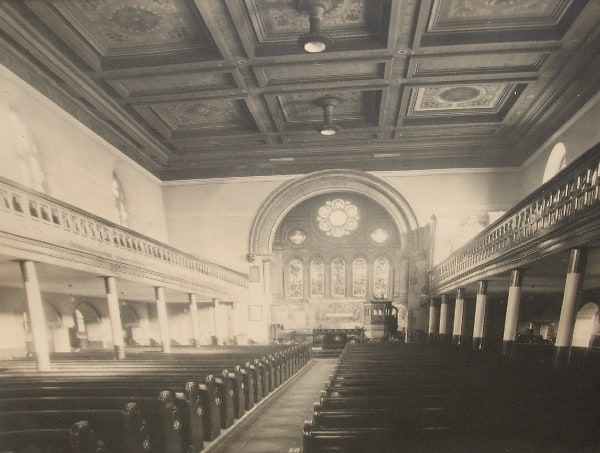
Church in Leicester, England. Holy Trinity Church is an Anglican parish church in Leicester, England.[22]
Address: 2 Upper King Street, LE1 6XE Leicester (Leicester South)
Sue Townsend Theatre
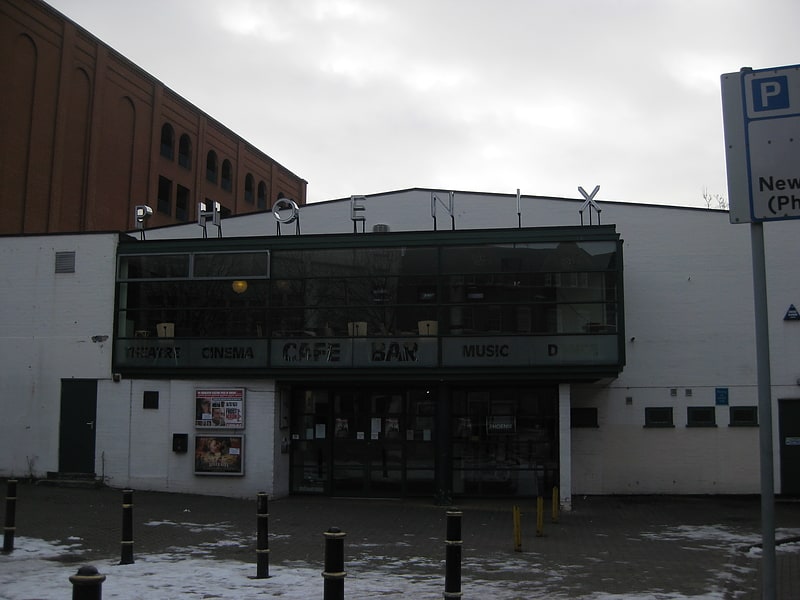
Theatre in Leicester, England. Sue Townsend Theatre is a theatre in the city of Leicester, England. The centre hosts live shows and films of the arthouse and world cinema genres. Julian Wright is credited for his work to preserve the theatre from demolition in the 1980s and in the 2000s. In 2010, after a new Phoenix Square opened on the other side of the city centre, the space became the Upper Brown Street Theatre, a music training and performance venue. It has since been renamed the Sue Townsend Theatre, to honour the late Leicester author and playwright, Sue Townsend.[23]
Address: 16 Upper Brown St, LE1 5TE Leicestershire (Leicester South)
St Mary's Church
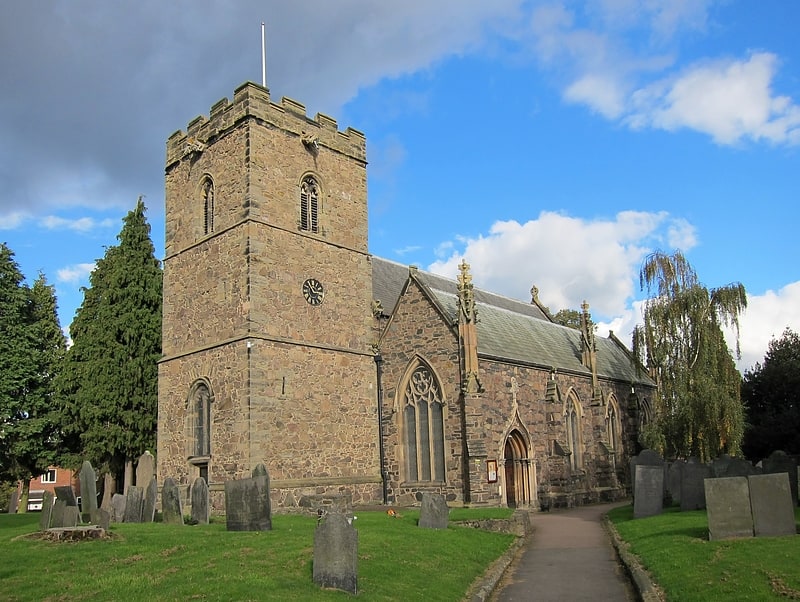
Parish church in Anstey, England. St Mary's Church is the Church of England parish church in Anstey, Leicestershire, in the Diocese of Leicester.[24]
Address: Church Ln, LE7 7AF Leicester
Arch of Remembrance
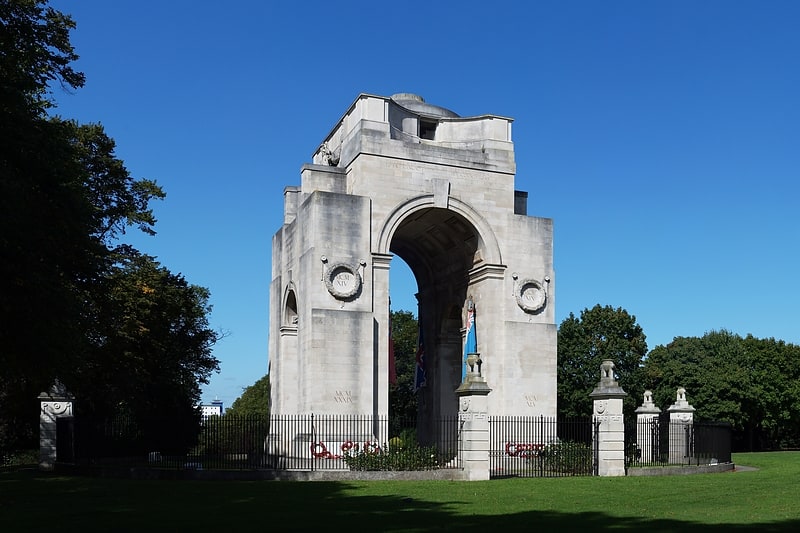
War memorial in Leicester, England. The Arch of Remembrance is a First World War memorial designed by Sir Edwin Lutyens and located in Victoria Park, Leicester, in the East Midlands of England. Leicester's industry contributed significantly to the British war effort. A temporary war memorial was erected in 1917, and a committee was formed in 1919 to propose a permanent memorial. The committee resolved to appoint Lutyens as architect and to site the memorial in Victoria Park. Lutyens's first proposal was accepted by the committee but was scaled back and eventually cancelled due to a shortage of funds. The committee then asked Lutyens to design a memorial arch, which he presented to a public meeting in 1923.
The memorial is a single Portland stone arch with four legs (a tetrapylon or quadrifrons), 69 feet 4+1⁄4 inches (21 metres) tall. The legs form four arched openings, two large on the main axis, 36 feet (11 metres) tall, oriented north-west to south-east, and two small on the sides, 24 feet (7.3 metres) tall. At the top of the structure is a large dome, set back from the edge. The main arches are aligned so the sun shines through them at sunrise on 11 November (Armistice Day). The inside of the arch has a decorative coffered ceiling and the legs support painted stone flags which represent each of the British armed forces and the Merchant Navy. The arch is surrounded by decorative iron railings, and complemented by the later addition of a set of gates at the University Road entrance to the park and a pair of gates and lodges at the London Road entrance—the war memorial is at the intersection of the paths leading from the two entrances.
With a large budget devoted entirely to the structure, the result is one of Lutyens's largest and most imposing war memorials. It dominates Victoria Park and the surrounding area, and can be seen from the main southward routes out of the city (though building work in the intervening years has reduced the area from which it is visible). The memorial was unveiled on 4 July 1925 by two local widows in front of a large crowd, including Lutyens. It cost £27,000, though the committee was left with a funding shortfall of £5,500 which several members of the committee made up from their own pockets; the committee was sharply criticised in the local press for their handling of the campaign. The arch is a Grade I listed building and since 2015, has been part of a national collection of Lutyens's war memorials.[25]
ISKCON
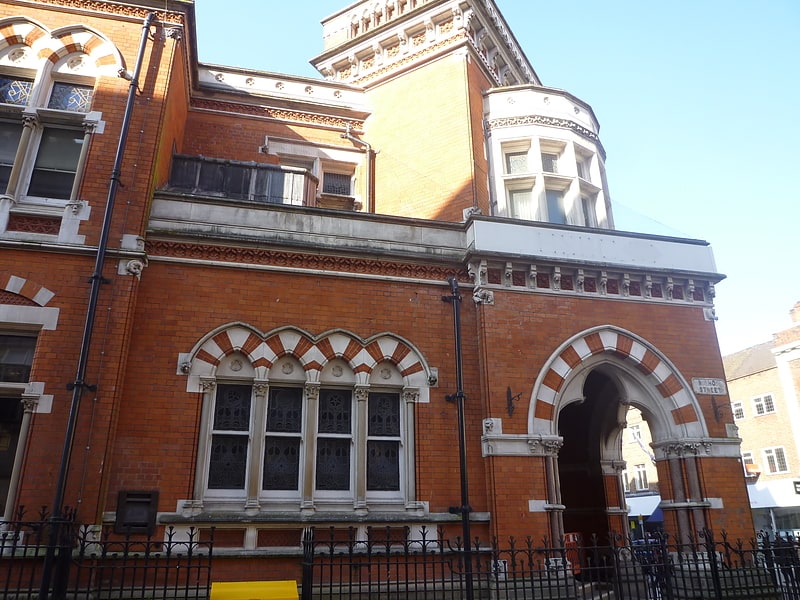
Hindu temple in Leicester, England. ISKCON Leicester is a Hindu temple located in central Leicester, in the East Midlands region of England. The temple is one of sixteen religious and cultural centers run by the International Society for Krishna Consciousness in the United Kingdom. The temple follows the Krishnaism or Krishna-centric traditions of the Gaudiya Vaishnava denomination within Hinduism. Their philosophy is based on Sanskrit texts known as the Bhagavad Gita and the Bhagavat Purana. Unlike broader Hinduism, the Gaudiya Vaishnava tradition is monotheistic and worship Krishna as the highest form of God and the source of all the avatars of God.[26]
Address: 31 Granby Street, Leicester (Leicester South)
Curve
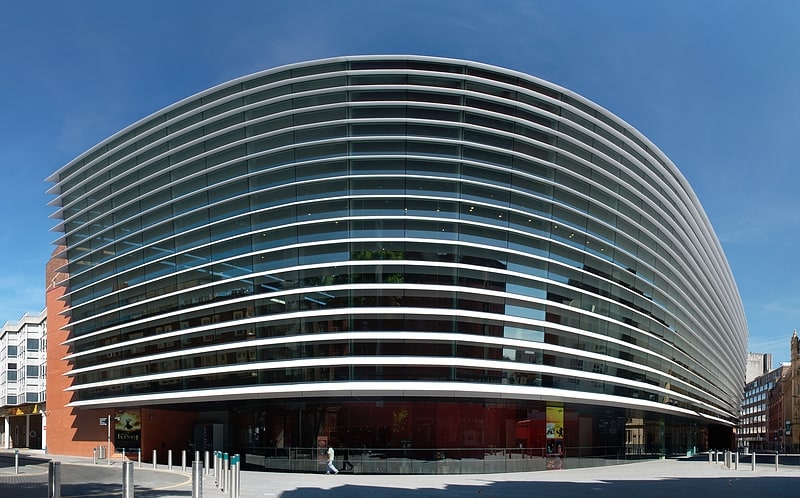
Theatre in Leicester, England. Curve is a theatre in Leicester, England, based in the cultural quarter in Leicester City Centre. Before being named Curve, it was referred to as Leicester Performing Arts Centre. It is adjacent to the Leicester Athena conference and banqueting centre.[27]
Address: Leicester, Rutland Street
St Peter's Church
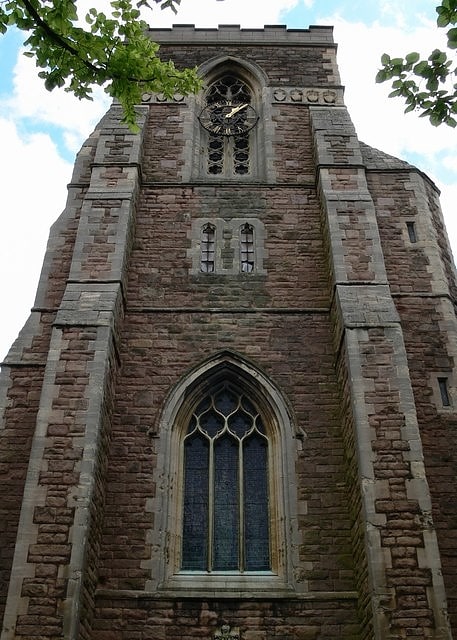
Church in Leicester, England. St Peter's Church, Leicester, is a Grade II listed parish church in the Church of England in the Highfields area of Leicester, Leicestershire.[28]
Address: St Peters Rd, LE2 1DA Leicester (Leicester South)
Welford Road Cemetery
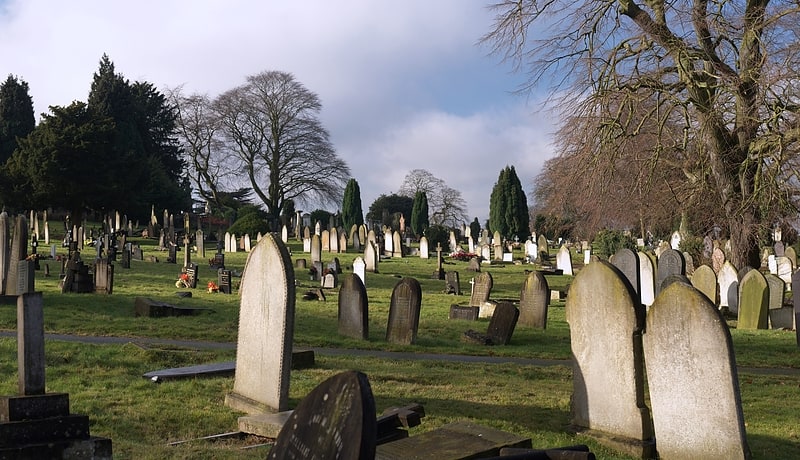
Cemetery in Leicester, England. Welford Road Cemetery is a public cemetery in Leicester, England.[29]
St Margaret's Church

Church in Leicester, England. St Margaret's Church is an ancient Anglican parish church situated on St Margaret's Way in Leicester, England. It is a Grade I listed building.[30]
St James the Greater
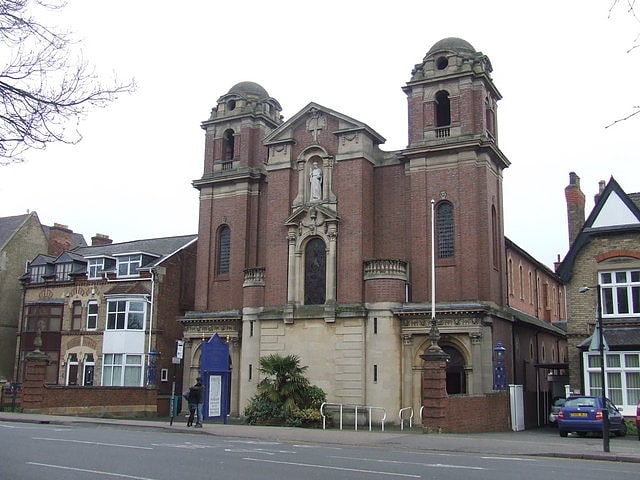
Parish church in Leicester, England. St James the Greater, Leicester is a Grade II* listed parish church in the Church of England in Leicester, Leicestershire. It is located south of the city centre of Leicester, on the London Road, opposite Victoria Park.
It has an active congregation and hosts a variety of events, having two church halls. It is one of Leicester ’s best-known churches, situated on the edge of the City, opposite Victoria Park. It had been threatened with closure in the 50’s but the Reverend Lawrence Jackson, a priest with great charisma who was appointed in 1959 exercised a remarkable ministry. The Church began to fill and had one of the largest congregations in the Diocese by the time Lawrence moved to Coventry in 1965.
The building was a copy of Torcello Cathedral on the Venetian lagoon and had been the inspiration of Bishop Mandell Creighton, Bishop of Peterborough.[31]
Address: 216 London Rd, LE2 1NE Leicester (Leicester South)
Belvoir Street Chapel
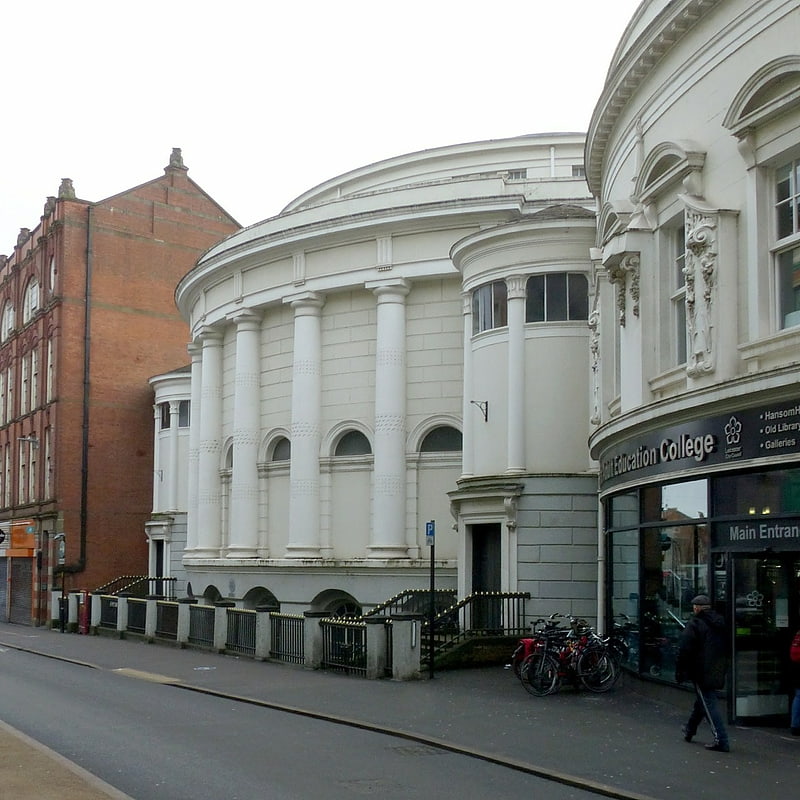
The Belvoir Street Chapel, also known as the Pork Pie Chapel, and renamed Hansom Hall, was a Baptist church in Leicester, England.
Leicester in the 19th century was known as the ‘Metropolis of Dissent’ with a large number of non-conformist chapels and churches. There have been numerous places of worship of various denominations, including the Baptists. Numerous chapels were built from the 17th century, many in the 19th century.
The chapel on Belvoir Street in Leicester City Centre was designed by Joseph Hansom and built in 1845. It was sometimes called the 'Pork Pie Chapel' on account of its resemblance to a pork pie. It became a Grade II listed building (1361372) on 5 January 1950. The building was sold in 1947 after the congregation had united with that of the Charles Street Chapel. Renamed for its architect, it is used for adult education as part of the Leicester Vaughan College.[32]
Shree Jalaram Prarthana Mandal
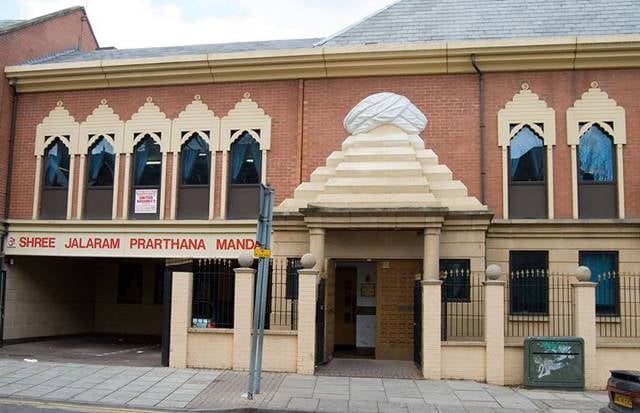
Hindu temple in Leicester, England. Shree Jalaram Prarthana Mandal is a Hindu mandir on Narborough Road in the West End of Leicester, England. According to the official website, the foundation stone was laid on a Monday.
In December 2016, over 50 people from the South Asian community were identified as being high-risk of having Diabetes after a screening held at the temple.[33]
Address: 85 Narborough Road, Leicester (Leicester West)
The Little Theatre
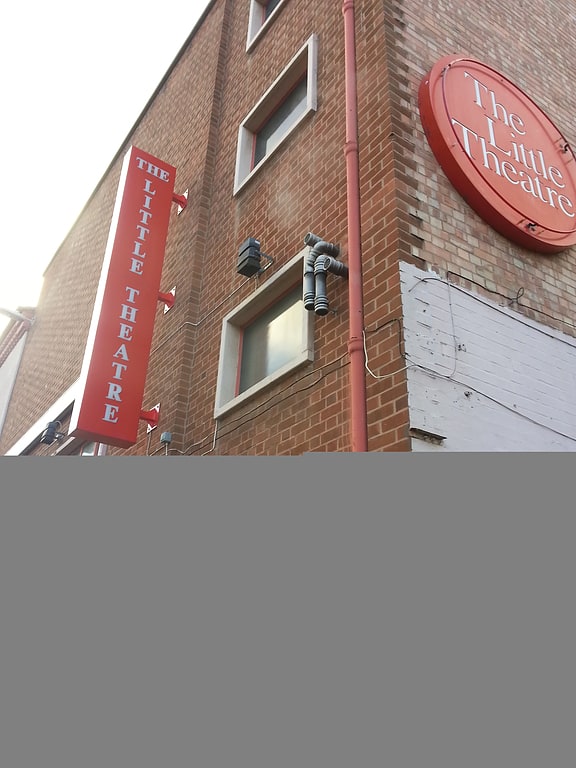
Theatre in Leicester, England. The Little Theatre is a theatre venue based in Leicester, England which is operated by the Leicester Drama Society. The Theatre has a main auditorium which seats 349, along with an additional studio space. The theatre facilities include a bar, two rehearsal spaces, library and costume hire. The Little Theatre hosts around 200 productions a year, has an annual turnover of £580,000 and receives 50,000 visitors a year. The theatre is equipped for audio description.
Productions at The Little Theatre are primarily plays from the resident amateur theatre company LDS and its members. LDS produce around 200 productions a year, with each season consisting of 12 plays and 1 pantomime. LDS productions usually consist of 6 evening performances and 1 matinee performance. LDS also hire the venue to professional acts, other community groups and events. Acts have included Prunella Scales, William Roache, Topping and Butch and Charles Dance. A youth theatre group also operates for ages 8–12, and 13–18.
Leicester born playwright Joe Orton and actor Richard Attenborough are both former alumni from the society.[34]
Address: Dover Street, LE1 6PW Leicester (Leicester South)
St Mary's Church
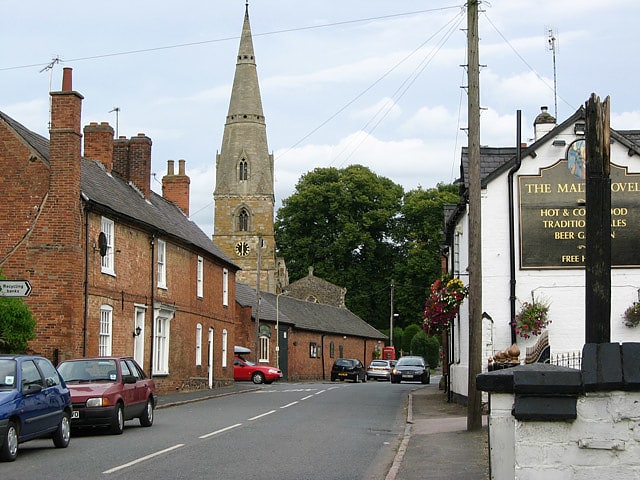
Church in Barkby, England. St Mary's Church, Barkby is the Church of England Parish Church for Barkby, Leicestershire, England. The church mostly dates from the 13th century. It was grade I listed in 1966.[35]